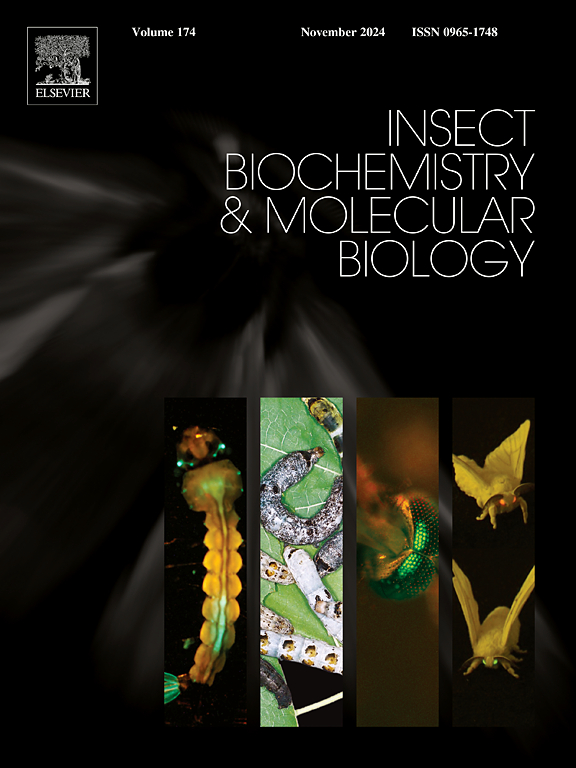昆虫变态过程中e93依赖性组织形态发生和组织分解的分子基础。
IF 3.7
2区 农林科学
Q2 BIOCHEMISTRY & MOLECULAR BIOLOGY
引用次数: 0
摘要
昆虫变态的进化深刻地影响了它们的成功适应和多样化。昆虫变态过程中有两个重要的生理过程:翅膀成熟和前胸腺(PG)的组织分解。蜕皮激素诱导蛋白93 (E93)是变态不可缺少的转录因子。虽然已经确定翅膀成熟和PG组织分解都依赖于E93,但E93调节这些看似“相反”事件的分子机制仍然知之甚少。在这项研究中,生成了半代谢模式昆虫德国小蠊(Blattella germanica)在变态过程中翅膀和pg的时间过程转录组谱。比较转录组学分析表明,E93在翅膀形态发生和PG组织分解过程中对广泛的基因转录起主导作用。在翅膀形态发生过程中,E93选择性地增强了与细胞增殖、能量供应、信号转导、肌动蛋白细胞骨架组织、细胞粘附等相关基因的表达。此外,E93还激活了翅膀基因网络中大多数基因的转录,这些基因对德国小蠊的翅膀发育至关重要。在PG组织分解过程中,E93优先促进内吞作用、局灶黏附、AMPK信号通路、脂肪细胞因子信号通路、Toll和Imd信号通路、自噬等相关基因的表达。参与上述途径的关键基因随后被证实有助于德国小蠊PG的e93依赖性变性。综上所述,我们的研究结果表明,E93在昆虫变态过程中作为一个主要的转录调节因子,协调组织形态发生和组织分解。这些发现有助于更深入地了解昆虫变态的遗传基础。本文章由计算机程序翻译,如有差异,请以英文原文为准。

Molecular basis of E93-dependent tissue morphogenesis and histolysis during insect metamorphosis
The evolution of insect metamorphosis has profoundly influenced their successful adaptation and diversification. Two key physiological processes during insect metamorphosis are notable: wing maturation and prothoracic gland (PG) histolysis. The ecdysone-induced protein 93 (E93) is a transcription factor indispensable for metamorphosis. While it has been established that both wing maturation and PG histolysis are dependent on E93, the molecular mechanisms through which E93 regulates these seemingly ‘opposing’ events remain poorly understood. In this study, time-course transcriptome profiles were generated for wing pads and PGs during metamorphosis in Blattella germanica, a hemimetabolous model insect. Comparative transcriptomic analyses demonstrated that E93 exerts predominant control over extensive gene transcription during wing morphogenesis and PG histolysis. During wing morphogenesis, E93 selectively enhances the expression of genes associated with cell proliferation, energy supply, signal transduction, actin cytoskeleton organization, and cell adhesion, etc. Additionally, E93 activates the transcription of the majority of genes within the wing gene network that are crucial for wing development in B. germanica. During PG histolysis, E93 preferentially promotes the expression of genes related to endocytosis, focal adhesion, the AMPK signaling pathway, adipocytokine signaling pathway, Toll and Imd signaling pathways, and autophagy, etc. The key genes involved in the aforementioned pathways were subsequently confirmed to contribute to the E93-dependent degeneration of the PG in B. germanica. In summary, our results reveal that E93 functions as a master transcriptional regulator orchestrating both tissue morphogenesis and histolysis during insect metamorphosis. These findings contribute to a deeper understanding of the genetic underpinnings of insect metamorphosis.
求助全文
通过发布文献求助,成功后即可免费获取论文全文。
去求助
来源期刊
CiteScore
7.40
自引率
5.30%
发文量
105
审稿时长
40 days
期刊介绍:
This international journal publishes original contributions and mini-reviews in the fields of insect biochemistry and insect molecular biology. Main areas of interest are neurochemistry, hormone and pheromone biochemistry, enzymes and metabolism, hormone action and gene regulation, gene characterization and structure, pharmacology, immunology and cell and tissue culture. Papers on the biochemistry and molecular biology of other groups of arthropods are published if of general interest to the readership. Technique papers will be considered for publication if they significantly advance the field of insect biochemistry and molecular biology in the opinion of the Editors and Editorial Board.

 求助内容:
求助内容: 应助结果提醒方式:
应助结果提醒方式:


